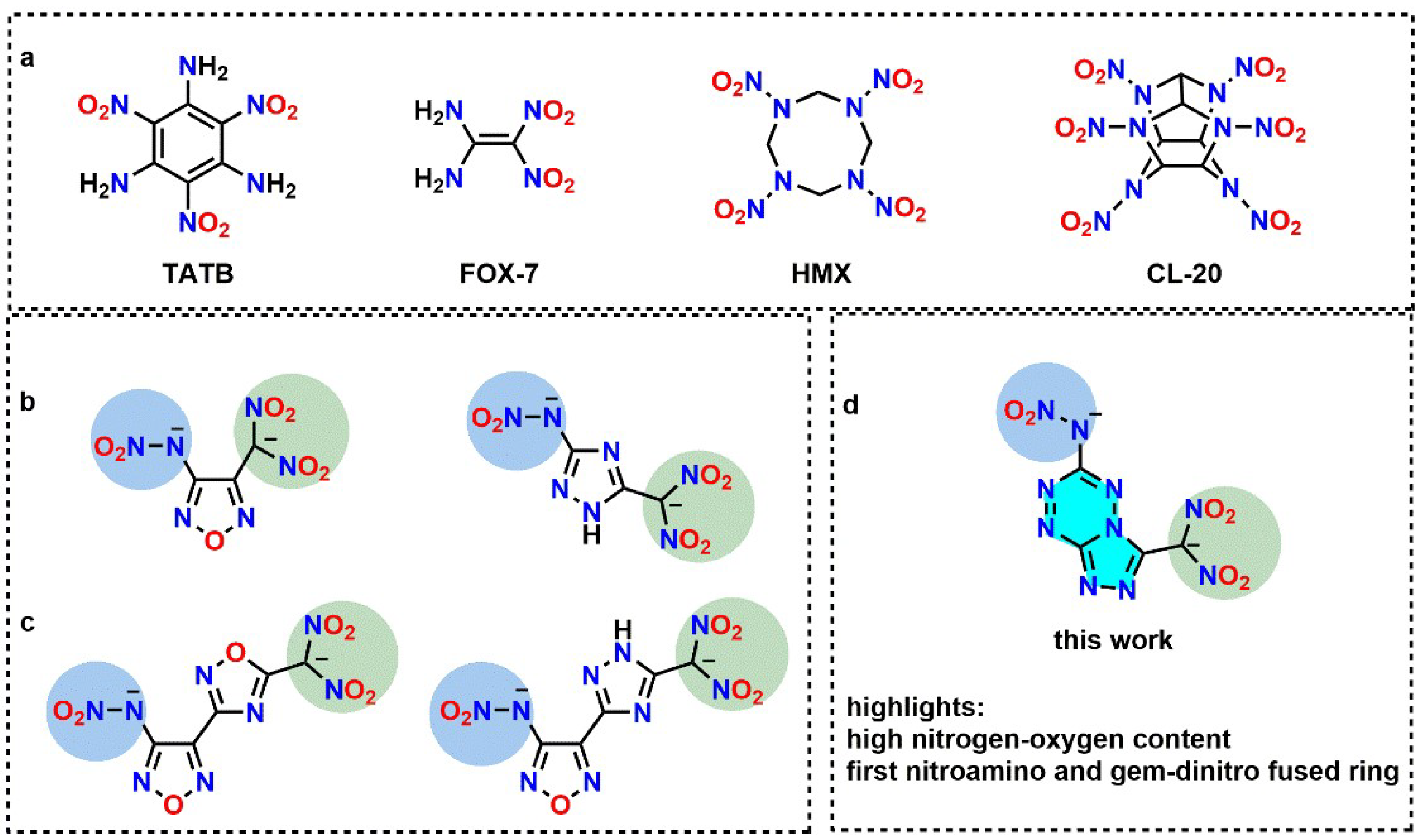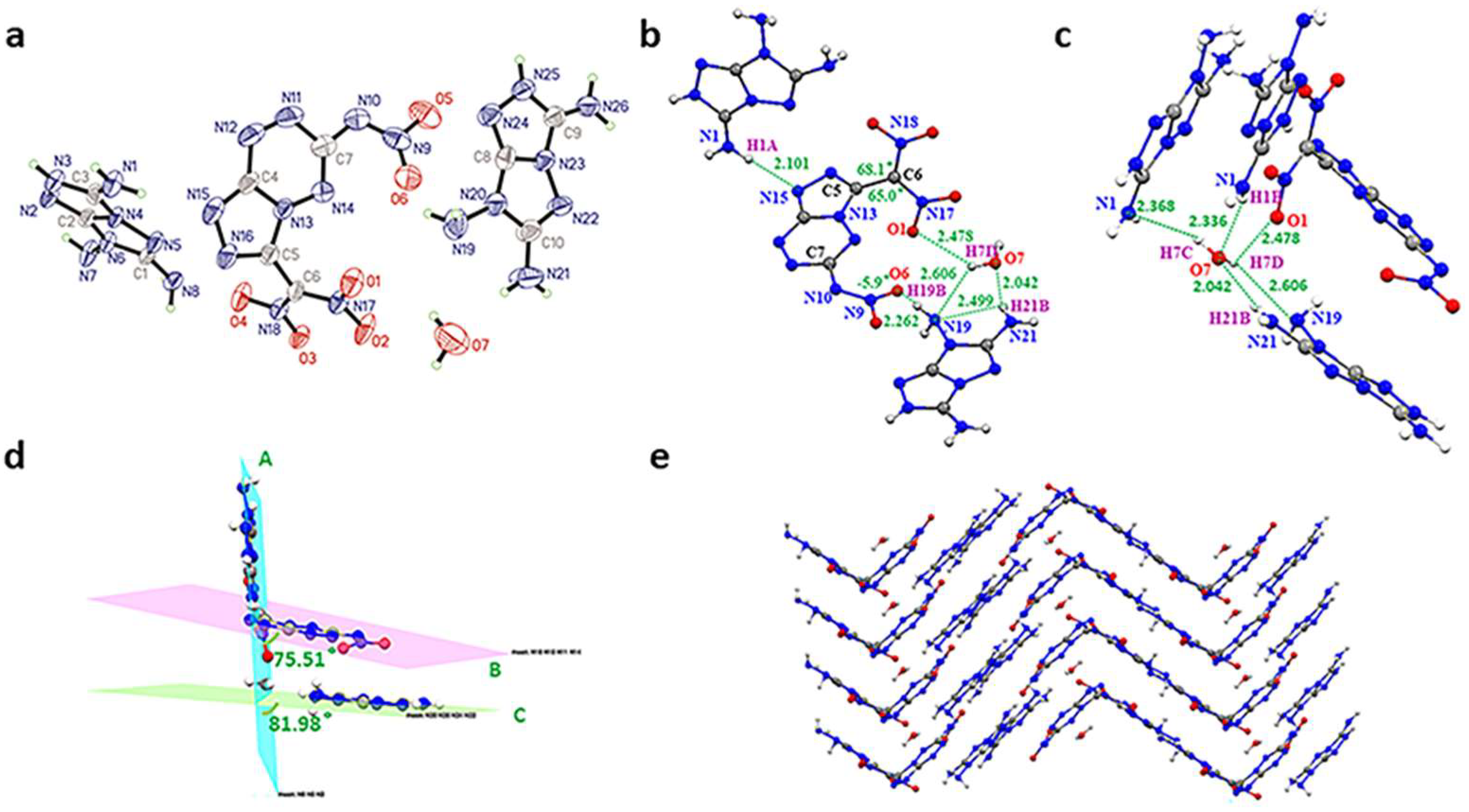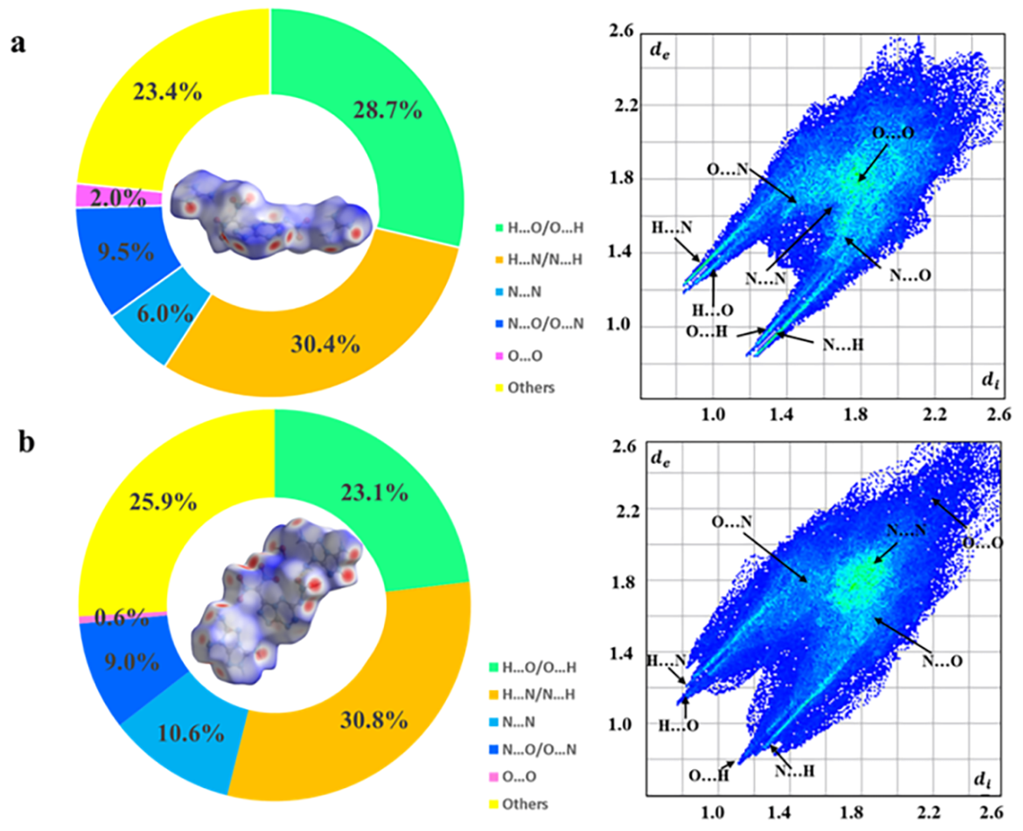Coordinative Combination of Nitroamine and Gem-Dinitromethyl with Fused Ring for Enhanced Oxygen Balances and Detonation Properties
Abstract
1. Introduction
2. Results and Discussion
2.1. Synthesis
2.2. Single-Crystal X-ray Analysis
2.3. Sensitivity
2.4. Physicochemical and Energetic Properties
3. Methods and Materials
3.1. Safety Precaution
3.2. General Methods
3.3. Potassium (3-(Dinitromethanidyl)-[1,2,4]triazolo[4,3-b][1,2,4,5]tetrazin-6-yl)(nitro)amide (1)
3.4. General Procedures for Synthesis of Compounds 2, 3 and 4
3.4.1. Ammonium (3-(Dinitromethanidyl)-[1,2,4]triazolo[4,3-b][1,2,4,5]tetrazin-6-yl)(nitro)amide (2)
3.4.2. Guanidine (3-(Dinitromethanidyl)-[1,2,4]triazolo[4,3-b][1,2,4,5]tetrazin-6-yl)(nitro)amide (3)
3.4.3. 3,6,7-Triamino-7H-[1,2,4]triazolo[4,3-b][1,2,4]triazol-2-ium(3-(dinitromethanidyl)-[1,2,4]triazolo[4,3-b][1,2,4,5]tetrazin-6-yl)(nitro)amide (4)
4. Conclusions
Supplementary Materials
Author Contributions
Funding
Institutional Review Board Statement
Informed Consent Statement
Data Availability Statement
Conflicts of Interest
References
- Ott, D.G.; Benziger, T.M. Preparation of 1,3,5-triamino-2,4,6-trinitrobenzene from 3,5-dichloroanisole. J. Energ. Mater. 1987, 5, 343–354. [Google Scholar] [CrossRef]
- Straessler, N.A.; Deschamps, J.R. Aliphatic Versus Aromatic Nucleophilic Attack of NH3 on Trialkoxy-trinitrobenzenes in the Preparation of TATB. J. Energ. Mater. 2013, 32, 60–70. [Google Scholar] [CrossRef]
- Latypov, N.V.; Bergman, J. Synthesis and Reactions of 1,1-Diamino-2,2-dinitroethylene. Tetrahedron 1998, 54, 11525–11536. [Google Scholar] [CrossRef]
- Li, J.; Liu, Y.; Ma, W.; Fei, T.; He, C.; Pang, S. Tri-explosophoric groups driven fused energetic heterocycles featuring superior energetic and safety performances outperforms HMX. Nat. Commun. 2022, 13, 5697. [Google Scholar] [CrossRef] [PubMed]
- Wang, Y.; Liu, Y.; Song, S.; Yang, Z.; Qi, X.; Wang, K.; Liu, Y.; Zhang, Q.; Tian, Y. Accelerating the discovery of insensitive high-energy-density materials by a materials genome approach. Nat. Commun. 2018, 9, 2444. [Google Scholar] [CrossRef] [PubMed]
- Gao, H.; Zhang, Q.; Shreeve, J.M. Fused heterocycle-based energetic materials (2012–2019). J. Mater. Chem. A 2020, 8, 4193–4216. [Google Scholar] [CrossRef]
- Hu, L.; Yin, P.; Imler, G.H.; Parrish, D.A.; Gao, H.; Shreeve, J.M. Fused rings with N-oxide and -NH2: Good combination for high density and low sensitivity energetic materials. Chem. Commun. 2019, 55, 8979–8982. [Google Scholar] [CrossRef] [PubMed]
- Chen, P.; Qiu, L.; Yin, P.; He, C.; Pang, S.; Shreeve, J.M. Unraveling the reactivity of the azo bridge in 3,3′-(5-dinitromethyl-1,2,4-oxadiazolyl)-4,4′-azofurazanate in the synthesis of energetic compounds. Chem. Commun. 2022, 58, 2874–2877. [Google Scholar] [CrossRef] [PubMed]
- Rudakov, G.F.; Sinditskii, V.P.; Andreeva, I.A.; Botnikova, A.I.; Veselkina, P.R.; Kostanyan, S.K.; Yudin, N.V.; Serushkin, V.V.; Cherkaev, G.V.; Dorofeeva, O.V. Energetic compounds based on a new fused bis[1,2,4]triazolo[1,5-b;5′,1′-f]-1,2,4,5-tetrazine. Chem. Eng. J. 2022, 450, 138073. [Google Scholar] [CrossRef]
- Tang, Y.; He, C.; Imler, G.H.; Parrish, D.A.; Shreeve, J.M. Energetic furazan-triazole hybrid with dinitromethyl and nitramino groups: Decreasing sensitivity via the formation of a planar anion. Dalton Trans. 2019, 48, 7677–7684. [Google Scholar] [CrossRef] [PubMed]
- Ma, J.; Tang, J.; Yang, H.; Yi, Z.; Wu, G.; Zhu, S.; Zhang, W.; Li, Y.; Cheng, G. Polynitro-Functionalized Triazolylfurazanate Triaminoguanidine: Novel Green Primary Explosive with Insensitive Nature. ACS Appl. Mater. Interfaces 2019, 11, 26053–26059. [Google Scholar] [CrossRef] [PubMed]
- He, C.; Imler, G.H.; Parrish, D.A.; Shreeve, J.M. Energetic salts of 4-nitramino-3-(5-dinitromethyl-1,2,4-oxadiazolyl)-furazan: Powerful alliance towards good thermal stability and high performance. J. Mater. Chem. A 2018, 6, 16833–16837. [Google Scholar] [CrossRef]
- Tang, Y.; Dharavath, S.; Imler, G.H.; Parrish, D.A.; Shreeve, J.M. Nitramino- and Dinitromethyl-Substituted 1,2,4-Triazole Derivatives as High-Performance Energetic Materials. Chem. Eur. J. 2017, 23, 9185–9191. [Google Scholar] [CrossRef] [PubMed]
- Huang, H.; Li, Y.; Yang, J.; Pan, R.; Lin, X. Materials with good energetic properties resulting from the smart combination of nitramino and dinitromethyl group with furazan. New J. Chem. 2017, 41, 7697–7704. [Google Scholar] [CrossRef]
- Hu, L.; Yin, P.; Zhao, G.; He, C.; Imler, G.H.; Parrish, D.A.; Gao, H.; Shreeve, J.M. Conjugated Energetic Salts Based on Fused Rings: Insensitive and Highly Dense Materials. J. Am. Chem. Soc. 2018, 140, 15001–15007. [Google Scholar] [CrossRef] [PubMed]
- Joo, Y.H.; Shreeve, J.M. High-density energetic mono- or bis(oxy)-5-nitroiminotetrazoles. Angew. Chem. Int. Ed. 2010, 49, 7320–7323. [Google Scholar] [CrossRef] [PubMed]
- Hu, L.; Gao, H.; Shreeve, J.M. Challenging the limits of nitrogen and oxygen content of fused rings. J. Mater. Chem. A 2020, 8, 17411–17414. [Google Scholar] [CrossRef]
- Zhang, X.; Wang, Y.; Liu, Y.; Zhang, Q.; Hu, L.; He, C.; Pang, S. Energetic Gem-dinitro Salts with Improved Thermal Stability by Incorporating with A Fused Building Block. ACS Appl. Mater. Interfaces 2022, 14, 37975–37981. [Google Scholar] [CrossRef] [PubMed]
- Spackman, M.A.; McKinnon, J.J. Fingerprinting intermolecular interactions in molecular crystals. Crystengcomm 2002, 4, 378–392. [Google Scholar] [CrossRef]
- Spackman, M.A.; Jayatilaka, D. Hirshfeld surface analysis. Crystengcomm 2009, 11, 19–32. [Google Scholar] [CrossRef]
- Becke, A.D. Density-functional thermochemistry. III. The role of exact exchange. J. Phys. Chem. 1993, 98, 5648. [Google Scholar]
- Stephens, P.J.; Devlin, F.J.; Chabalowski, C.F.; Frisch, M.J. Ab Initio Calculation of Vibrational Absorption and Circular Dichroism Spectra Using Density Functional Force Fields. J. Phys. Chem. 1994, 98, 11623. [Google Scholar]





| Compound | Td a (°C) | ρ b (g cm−3) | ΔHf c (kJ mol−1) | D d (m s−1) | P e (Gpa) | IS f (J) | FS g (N) | N + O h (%) |
|---|---|---|---|---|---|---|---|---|
| 1 | 222.9 | 2.062 | 172.6 | 8040 | 28.1 | 15 | 160 | 65.2 |
| 2 | 152.2 | 1.805 | 439.7 | 8900 | 32.4 | 15 | 240 | 82.5 |
| 3 | 228.4 | 1.629 | 485.1 | 7892 | 23 | 40 | 360 | 79.2 |
| 4 | 170.8 | 1.817 | 1627.3 | 8789 | 29.8 | 40 | 160 | 77.4 |
| S1 | 197 | 1.756 | 564.3 | 8574 | 29.4 | 35 | 240 | 79.1 |
| RDX | 204 | 1.8 | 70.3 | 8795 | 34.9 | 7.5 | 120 | 81.1 |
Publisher’s Note: MDPI stays neutral with regard to jurisdictional claims in published maps and institutional affiliations. |
© 2022 by the authors. Licensee MDPI, Basel, Switzerland. This article is an open access article distributed under the terms and conditions of the Creative Commons Attribution (CC BY) license (https://creativecommons.org/licenses/by/4.0/).
Share and Cite
Zhang, X.; Wang, Y.; Zhao, X.; He, C.; Pang, S. Coordinative Combination of Nitroamine and Gem-Dinitromethyl with Fused Ring for Enhanced Oxygen Balances and Detonation Properties. Int. J. Mol. Sci. 2022, 23, 14337. https://doi.org/10.3390/ijms232214337
Zhang X, Wang Y, Zhao X, He C, Pang S. Coordinative Combination of Nitroamine and Gem-Dinitromethyl with Fused Ring for Enhanced Oxygen Balances and Detonation Properties. International Journal of Molecular Sciences. 2022; 23(22):14337. https://doi.org/10.3390/ijms232214337
Chicago/Turabian StyleZhang, Xun, Yaxi Wang, Xinyuan Zhao, Chunlin He, and Siping Pang. 2022. "Coordinative Combination of Nitroamine and Gem-Dinitromethyl with Fused Ring for Enhanced Oxygen Balances and Detonation Properties" International Journal of Molecular Sciences 23, no. 22: 14337. https://doi.org/10.3390/ijms232214337
APA StyleZhang, X., Wang, Y., Zhao, X., He, C., & Pang, S. (2022). Coordinative Combination of Nitroamine and Gem-Dinitromethyl with Fused Ring for Enhanced Oxygen Balances and Detonation Properties. International Journal of Molecular Sciences, 23(22), 14337. https://doi.org/10.3390/ijms232214337





